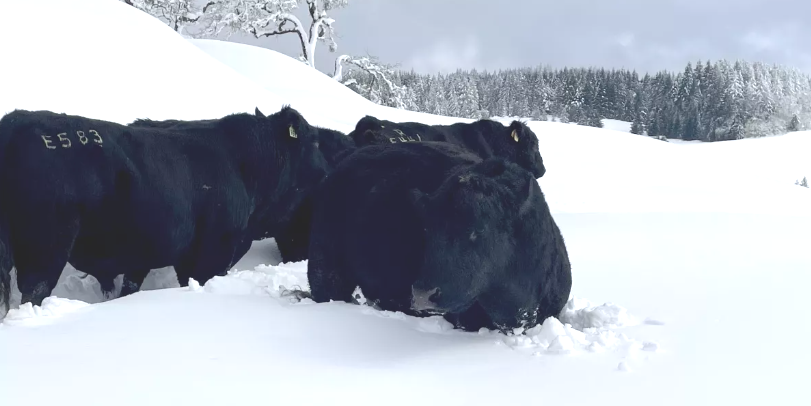Erika Lundy-Woolfolk, ISU Extension Beef Specialist
In the spring, cattle get a portion of their daily water requirements from lush pastures, but does that apply to snow during the winter months as well?
The short answer is yes, assuming adequate quantity and quality, snow can help offset the consumption of regular water; however, snow shouldn’t be relied on as the sole water source. Typical water consumption by mature beef cattle in the winter months is between 10 – 15 gallons per day. Depending on the moisture content of the feed being fed, up to about a third of the cow’s water requirements can be met from water consumed in dietary form.
Previous Canadian research from the 1980’s looked at the impact of mid-gestation cows’ live weight or body fat deposition during a 60-day period where cows had continuous access to water, restricted time access to water each day, or no access to water (snow only). Results showed no negative impacts on performance of the cows regardless of water or snow access, suggesting that energy requirements did not significantly increase by consuming snow as the water source.
A study in Montana found that only 65% of cows drank water daily with an additional 33% coming to the water source every 2nd or 3rd day when adequate snow was available. While the average snowfall here in the Midwest is fraction of that in Canada and the western states, this data suggestions that cattle could utilize snow as their predominant water source temporarily if deemed necessary by Mother Nature.
After several years of drought conditions and heavy snowfall and extreme cold temperatures during the month of January, continuous access to quality water this winter has been hard to maintain for cow herds out on cornstalks. Here are some tips when considering temporarily relying on snow as a water source (assuming winter isn’t really over yet!).
Clean snow is key... Ice-covered or windblown snow possesses a challenge for cattle to physically consume, and snow that has been trampled or contaminated will deter consumption.
Monitoring feed intake can be a helpful tool in determining if cattle are consuming enough water. A quick thumb rule is that mature cows should be eating about 2.5% of their body weight during late gestation. If feed intake drops, insufficient water access is likely.
During the winter months, cattle tend to only consume water a couple times a day, typically after feeding. If forced to only consume snow, cattle’s eating behavior may change, alternating between eating feed and snow, resulting in longer for cattle to clean-up feed. Remember water is necessary to help with digestion and rate of passage.
Forcing cattle to only eat snow may lead to an increase of cattle wandering, pressuring fences, or walking out on ice-covered ponds/streams. Remain diligent on keeping water access open to prevent negative impacts on health and performance. Once water is reestablished, be prepared for increased competition of the herd to try to drink at once.
When given the choice, cattle tend to consume the greatest amount of water when the water temperature is above 35 degrees during the winter months. However, cattle and producers can rely on snow consumption to temporarily meet water requirements assuming adequate snow is available when incremental weather hits. Monitoring and prioritizing cattle health and welfare are necessary during these times to prevent dehydration.
Source: Iowa State University














